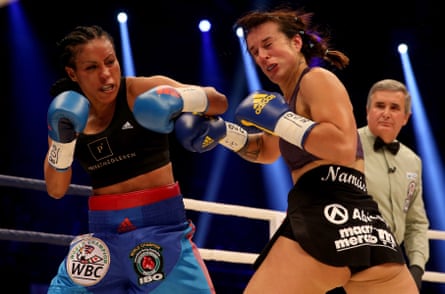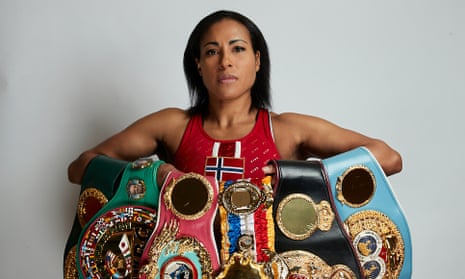Cecilia Brækhus, the world’s best female prizefighter, is right at home in Big Bear Lake, the high-altitude training refuge nestled in California’s San Bernardino Mountains. The placid, bucolic surroundings remind her of Bergen, the city tucked among the snowcapped peaks and glacial fjords on Norway’s west coast that’s been her hometown for as long as she can remember. So when the coronavirus pandemic scuttled her scheduled April fight with the American contender Jessica McCaskill, Brækhus was happy to shelter-in-place alongside trainer Abel Sanchez and wait for a new date rather than return to Europe and risk not being allowed back into the US.
“Closing the borders, the travel restrictions, all the health warnings,” Brækhus told the Guardian this week. “There was so much going on and everything was so uncertain, so I just said I’m going to stay here. Here I am safe and I’m healthy and I can be outside and I have nature around me. I’m in one of the safest places you can be.”
Brækhus, the undisputed welterweight champion who is unbeaten in 36 professional fights, will finally climb through the ropes to defend her WBA, WBC, IBF and WBO titles against McCaskill on Saturday night in a purpose-built ring on the streets of downtown Tulsa, Oklahoma. Unlike the star-crossed Trump rally that took place a few blocks away in June, no spectators will be present and strict health and safety protocols will be in place. Essentially, it’s a made-for-TV production for Dazn, the upstart subscription streaming service which is broadcasting the fight in the US and abroad.
It’s been more than 11 years since Brækhus first became a world title-holder at 147lbs, a preposterously long reign in a sport where a champion’s mental and physical toughness are always being put to question. Since unifying the belts of all four major sanctioning bodies in 2014, she’s been widely regarded as the sport’s pound-for-pound world No 1. Should she win on Saturday as expected, the 38-year-old Norwegian will eclipse the legendary Joe Louis’s record of 25 consecutive successful title defenses. By any metric, she is an all-time great.
Yet due to a lack of investment in female fighters by TV networks and promoters, Brækhus has been unknown to all but dedicated boxing fans for most of her Hall of Fame career. Even as Ronda Rousey was lifting women’s mixed martial arts from obscure sideshow derided by UFC president Dana White to headline attraction, offering compelling proof of concept of a woman’s drawing power in a traditionally hyper-masculine space, Brækhus found herself relegated to the margins of a sport where men with résumés similar to hers are routinely among the world’s highest paid athletes.
“For a long time there was a stigma against women fighters,” Brækhus said. “It took 100 years for women to be allowed in the Olympics, which is crazy. There’s not enough investment from promoters in talent and the big fights. What is so strange is we saw what the UFC was doing but we couldn’t implement that in boxing. The reason why women worked for them is because they always put the same marketing and promotion behind their women as their men.”

There are signs Brækhus’s sport is finally catching up. The introduction of women’s boxing to the Olympic programme for the 2012 London Games has given rise to a wave of female fighters who are already familiar to the public before they turn professional – including Mikaela Mayer, Marlen Esparza and the incandescent Claressa Shields – which has made them more attractive to promoters. None from this class is bigger than Katie Taylor, the Olympic gold medalist from Ireland who has already unified the lightweight championship in the span of 14 pro fights and appears to be the gamest challenger to Brækhus’s pound-for-pound mantle.
The delicious prospect of a summit meeting with Taylor, which surely would be the biggest women’s fight ever and could help vault the sport to a new level of mainstream visibility, is why Braekhus last year signed with Eddie Hearn, the Matchroom Sport group managing director who has made a deeper commitment to female fighters than any other promoter today.
Yet Braekhus, whose nickname (The First Lady) speaks both to her stately comportment and trailblazing origins, has been around long enough to know that anything even approaching gender equity will only come through a sustained investment.
“People always think that one thing or one fight will change women’s boxing, but that’s not the issue,” Brækhus said. “There are a lot of different pieces to the puzzle all working together. Getting women’s boxing into the Olympics became a great platform for talent coming up. Then you have me: I have sold 10,000 tickets and sold pay-per-views and other women have done it too over in Europe. Then you have the #MeToo movement, which gave women all over the world a huge boost. The success of women in the UFC was also a big thing. What Eddie Hearn is doing right now with building a big brand and stable around women’s boxing. All these things working together is what’s bringing it to the next level.
“So now we just have to get paid for it, too.”

A Colombian-born orphan who was adopted by a Norwegian couple when she was two, Brækhus took up kickboxing against her parents’ wishes as a teenager, stealing away from the family’s fourth-floor flat by shinnying down the fire escape to train in secret at a local gym. She switched over to boxing when she was 21, winning all but five of her 80 amateur bouts and taking gold at the 2005 European championships, before deciding to make a career of it. Since professional boxing was outlawed in Norway, that meant relocating to Germany.
“When I started, women with muscles were frowned upon in a lot of places,” Brækhus said. “A girl wasn’t encouraged to do martial arts at all. It was hard to find trainers. I was the only girl in the gym. We weren’t allowed to go to the Olympics. Today, it’s a different world from when I started. It’s just amazing to be a part of what’s happening right now.”
An efficient, well-schooled boxer with quick hands, hair-trigger reflexes, fluid upper body movement and impeccable footwork, Brækhus saw off Denmark’s Vinni Skovgaard to capture the vacant WBA and WBC titles in her 11th pro outing. But she showed a fortitude beyond the bounds of technical ability in 2014, when she outpointed Germany’s Jennifer Retzke comfortably despite suffering a triple fracture in her right foot during the third round and limping to the finish line. That same year, three months after defeating the Croatian champion Ivana Habazin to become the first woman to unify all four major title belts in any weight class, Norway’s parliament voted to repeal the country’s 33-year-old ban on professional boxing, clearing the way for the prodigal daughter to fight on home soil.
In October 2016, before a rollicking sold-out crowd at the Oslo Spektrum that included Norwegian prime minister Erna Solberg, Brækhus delivered a sensational second-round knockout in a rematch with French rival Anne Sophie Mathis, who had offered the stiffest test of the Norwegian’s career in their first encounter four years earlier.
Some critics have theorized that female boxers, whose fights generally consist of two-minute rounds, should move to three-minute sessions if they want to be viewed as equal, a line of reasoning that observers of women’s tennis are all too familiar with. But Brækhus rejects the premise as a red herring, insisting it misses the larger point.
“We women, we don’t have a problem with going three minutes for rounds,” she said. “That’s not a problem. Women have done three-minute rounds before. The problem is we’re being asked to give more, always just to give up more, to do more. It’s not about the three-minute rounds. It’s like we can never do enough. It can be exhausting.”
She continued: “It feels like it’s never enough for us. We came to the Olympics and still there were big discussions about [the merits of] women’s boxing even though there were so many talented women and girls out there. And there still are. We will just hope that promoters will just start doing the right thing. What happened to that? Just promote women, invest in talent and it will pay off.”
Rather than hash over hypothetical rule changes, Brækhus prefers to focus on the task at hand.
“She’s very hungry,” Brækhus said of McCaskill, a St Louis native who has won three straight since a 2017 defeat to Taylor. “She knows exactly what’s going to happen if she beats me. She’s proven herself against the best win the world. She fought Katie when she was very fresh and new. She’s very hard-working, very dedicated. I’m not looking for an easy fight here at all.
“And if both me and Katie win our next fights and face each other, it would be the biggest fight in women’s boxing ever, by no comparison. You would have all of England, you would have all of the Nordic countries, it would be followed over here in the States. I would say Madison Square Garden would be a nice place to have a fight like that.”
